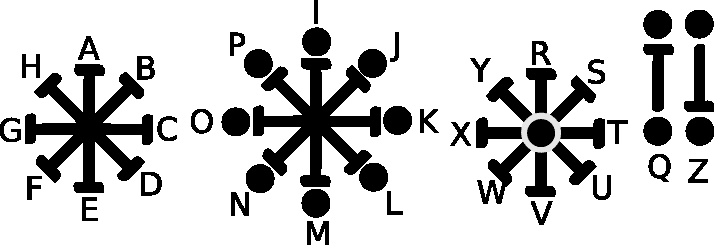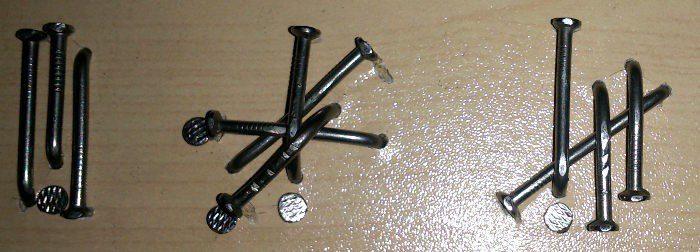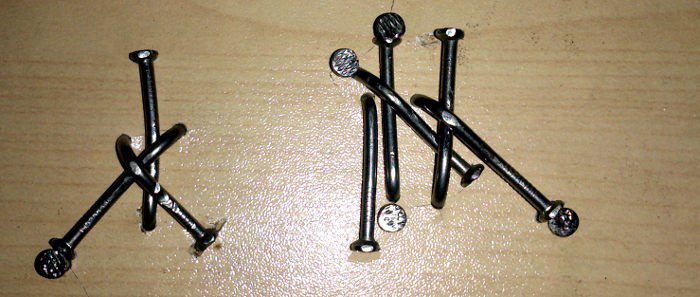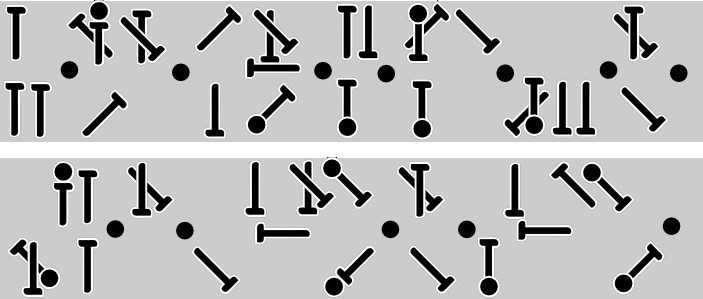NailScript: Text as Tuff as Nails…Literally!
Author: Matthew M. DeBlock
MS Date: 04-15-2014
FL Date: 05-01-2014
FL Number: FL-000020-00
Citation: DeBlock, Matthew M. 2014. «NailScript: Text as
Tuff as Nails…Literally!» FL-000020-00, Fiat
Lingua,
2014.
Copyright: © 2014 Matthew M. DeBlock. This work is
licensed under a Creative Commons Attribution-
NonCommercial-NoDerivs 3.0 Unported License.
!
http://creativecommons.org/licenses/by-nc-nd/3.0/
Fiat Lingua is produced and maintained by the Language Creation Society (LCS). For more information
about the LCS, visit http://www.conlang.org/
Text As Tuff As Nails… Literally!
Inspired by Cuneiform and shoddy carpentry, NailScript is a
constructed Script or “conscript”. A Conscript is an invented
writing system, or a form of code. NailScript differs from most
conscripts in that it is designed to allow text to be written
with nails and a hammer as opposed to pen, pencil or engraving.
The script can be written with standard writing tools, but the
true efficiency and unique characteristics of the script don’t
come into play unless it is written with nails. It obviously
does not compete with other writing systems in standard
measures, it is meant for special application and novelty.
The main advantages specific to writing with nails are:
1. Depth Layers – Unlike writing with a pen or pencil, when
you lay one nail on top of another nail you can see which
is above and which is below. This means the actual sequence
in which the “lines” were drawn is available. Unlike with a
pen, if you were to draw an X for example you would not
know which line was drawn first and which second. With
nails it would be obvious because the first nail would be
underneath the second nail.
2. Directional – The head of a bent nail is very distinct from
the entry point without a head, making the direction of
“line” also visible. Something very hard to identify with
lines drawn by pen or pencil.
3. Durable – Iron nails are strong, and will last significant
weathering, unlike inks and paints. Lower quality nails
will rust if exposed to the elements, but even this will
likely outlast any form of ink/paint based writing.
4. Readily available. Nails and hammers are universally
available and cheap. If you wanted to leave text of a
similar “permanence” special tools and materials would be
required for standard scripts.
NailScript English Index – Single Row Version
Nails are set in the wood then bent down, there are 8 possible orientations, and an
extra nail can be pounded fully down to act as a “dot” which can be placed at the
nail head or at the “base”(where the nail enters the wood).
Below reads : “All human beings are born free and equal in dignity and rights”
This example above spaces each letter individually.
Letters can be “sucked together tightly” to save space in many places.
The real fun begins when you start to allow nails to be laid over top of other nails
In this example some nails are overlapped. There are white outlines around each nail so
if you look closely you can see which is below and which is above. Not all nails can
overlap all other nails of course, 2 vertical nails of course are difficult, if not impossible,
to overlap. In this example I only use overlaps when it preserves the left-right order (the
lower nail is also always the left-most nail.)
Rats Nest style
In this example the nails are overlapped almost as much as possible. The sequence of
letters is primarily preserved by the layers. Previous letters are underneath following
letters.
One must be careful with the “dots” and make sure that they are not laid down in ways
that make it unclear which nail they belong to. You could consider conserving some
nails by allowing letters to “share dots” but I have not used this at all yet.
You can actually get very creative in how to bundle them up into tight “rats nests” of
what look like “a 6 years olds attempt to hammer nails” and with simple rules like
bottom layer → top layer, as well as “top → bottom, left to right (when the first rule
does not make it clear) letter sequence is preserved and it is legible.
The longer the nail, the more you can overlap.
Here is a real life version.
(Layers are pretty obvious in the picture, even more obvious in real life)
On the next page are zoomed in higher quality pics of the words. As you can see this
“rats nest” style may be hard to read in a low quality picture, but it is quite easy in real
life.
All
Human
Beings
Are
Born
Free
And
Equal
NailScript English Index – Double Row Version
In this version of NailScript there is an imaginary line dividing the board horizontally
into 2 rows. If you find it difficult to read or write without seeing the line, you can easily
grab something long and straight and score a line down the board, using a nail or
anything sharp, so you can see the mid-line as you hammer in the nail.
In the index above imagine the mid-line crosses through the middle of the circles.
Unlike the Single row version, the double row version splits letters between the 2 rows.
I use the “dot” on the center line as a “space character” which allows the words to be
drawn slightly tighter together (space between words is smaller) than the single row
version. I do not use dots in the middle because there are more possibilities available in
the double row version, and by omitting dotted horizontal lines the letters can be
tightened up together more without risk of ambiguity. It would be hard to draw multiple
horizontal stokes together and still be clear which a dot belongs to.
Below reads : “All human beings are born free and equal in dignity and rights”
This example above spaces each letter individually.
Next you can allow letters to exist sharing space vertically. To do this I prefer to use the
rule “read left to right, and when there are letters in both the top and bottom rows, read
top first, then read bottom, then move again to the right.”
This means you can only “piled up”, using both rows simultaneously, roughly one
quarter of the time (on average). “Left Top + Right bottom” can be merged, but “Left
Bottom + Right Top Cannot”, needless to say “Top+Top” and “Bottom+Bottom” cannot
be merged in this way either
In the next picture you will see the above text again using this simple «pile-up” rule.
Notice, for example, the first word “ALL”, the A and first L share space.
The first 2 letters D and I in “DIGNITY” (3rd word, second line) cannot share space
because that would read “ID” not “DI”. You could choose to reverse this rule, but either
way, how often you can save space is “luck of the draw”. Or you could choose to always
save space and hope the reader can figure out the ambiguity from context.
Finally you can overlap letters. The sequence will be obvious by simply seeing which
nail was “laid down first”, as it will be the nail on the bottom layer.
In double row NailScript there is much less opportunity to overlap when compared to
the single row version. This is simply because every time you switch from top row to
bottom row, or bottom row to top row, you must stop overlapping.
Double Row NailScript sacrifices the ability to compress each word into a “rats nest”,
but the having the extra dimension of rows allows a better “horizontal compression”,
largely because it allows for more distinct letters, which allows us to just drop the
horizontal lines, and horizontal lines are what consume the most horizontal space.
If the board you are writing on is wide then double row nail script likely make best use
of space. If the board is narrow then Single row NailScript is easier employ.
This example is the same text again but it employs overlapping when it is possible to
overlap.
All
Human
Beings
Are
Born
Free
In the picture above I have tried to overlap the nails as much as possible. This example
shows a “relatively clear” version of what I call “minor ambiguity”.
Notice the word “Beings. The letters E and I both start at nearly identical “horizontal
offsets”. It is not entirely clear if it is spelled BEINGS or BIENGS.
It is rather obvious from context which is correct, but I personally prefer to avoid such
ambiguities. In this case it is used because it allows compressing the word together and
more overlapping, a sort of way of getting around “top-bottom/bottom-top” switching
which normally limits the opportunity for overlaps.
Tips
• Longer nails allows for easier overlapping
• Be careful to ensure it is clear which nail a “dot” belongs to
• After bending down the nail, be sure to hit it until the nail head is planted firmly
in the board. This will prevent the nail from spinning. If you leave it in loose it is
possible it could spin like the arm of a clock, thus transforming into other letters.
(normally the bend alone will help hold it in place to some degree, because at the
point of entry it curves and pushes into the wood in the direction of the bend)
• Usually a few good hits with the hammer are enough to plant the head and
solidify the line, but if you have trouble preventing spin for some reason, a touch
of lacquer, glue or paint should work wonders.
• Nails exposed to weather will start to rust over time, this will help “lock down”
their position. If you want to speed this up just wet it down after you are done. (if
you want your nails to rust but they are of high quality and treated to prevent rust,
try scratching them up a bit before planting them in the board)
I originally had a warning here asking that people please don;t “mutilate trees” with
NailScript and instead use the traditional carving into the bark as I guessed it would be
less harmful than nails. It was pointed out to me by Matt G. in the conlang mailing list
that “putting iron nails into trees is a forestry method for treating iron deficiency.
Cutting into the bark is more harmful, as it disrupts more of the cambium, which is the
only part of the trunk that’s alive.” I am not sure if there is a potential risk of “excessive
iron supplement” should you place too many nails, but it appears that it might actually
be better than carving in the bark.
**If you like NailScript you will probably also like WireScript, a 2D/3D writing system that can be
written by bending wires. Works great for art, sculptures and jewelry.
http://dscript.org/wirescript.pdf
**You may also like Dscript, a 2D writing system. Dscript allows you to write text very flexibly in 2D,
and “turn word into symbols and glyphs”.
http://dscript.org/
dscript.pdf
**I have also Developed some fun “Mad Science”/”Technology Art” inventions and experiments.
Great DIY fun.
http://dscript.org/inventions.pdf
Dscript by Matthew DeBlock is licensed under a Creative Commons Attribution 3.0 Unported
License.
Based on a work at www.dscript.ca and www.dscript.org
















